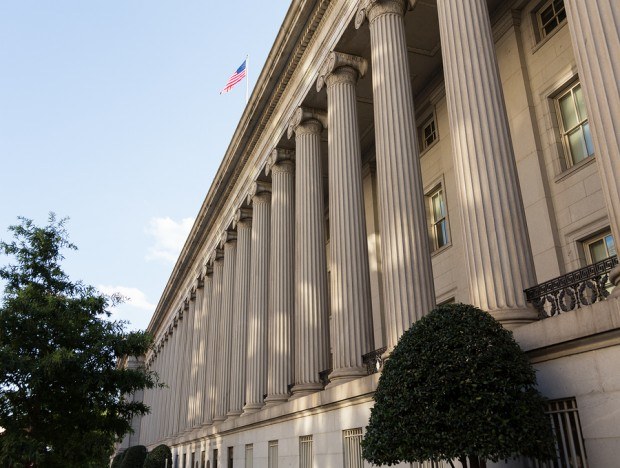 The federal terrorism risk insurance program “remains an important mechanism” for ensuring that terrorism risk insurance is available and generally affordable, the U.S. Treasury Department concludes in a new report.
The federal terrorism risk insurance program “remains an important mechanism” for ensuring that terrorism risk insurance is available and generally affordable, the U.S. Treasury Department concludes in a new report.
But Treasury officials want some changes, such as a requirement that participating insurers set aside a portion of the premiums they collect under the program for future terrorism claims.
Treasury also revealed it will propose requiring mandatory reporting of terrorism risk information by participating insurers beginning in 2017. Data submission is currently voluntary.
The Terrorism Risk Insurance Program (TRIP) provides a federal backstop for certain U.S. property/casualty commercial lines insurance losses resulting from a certified act of terrorism. The Report on the Overall Effectiveness of the Terrorism Risk Insurance Program is called for by the Terrorism Risk Insurance Program Reauthorization Act of 2015, which became law on January 12, 2015.
The report from the Treasury’s Federal Insurance Office (FIO) concludes that on a national basis, the coverage that is being made available on TRIP-eligible lines is is comprehensive and “would likely not be possible in the absence of the program.”
Regarding retention of premiums for future terrorism losses, the report estimates that insurers have collected $24.24 billion in premiums under the federal program since 2003 but have not had to pay any claims. While the FIO says it recognizes that a portion of the premium is to cover the cost of the capital that insurers devote to surplus to support providing terrorism risk insurance,” it also notes that the premium has contributed “at least to a modest extent” to increasing the surplus levels of participating insurers, which can help them remain solvent following a significant terrorism loss.
Thus, says, the report, policymakers may consider “whether some amount of the premiums charged for terrorism risk should be segregated in some fashion to support future terrorism risk.”
To date, an event has never been certified as an “act of terrorism” under the federal program.
Private Insurers
[The Treasury evaluation of TRIP comes at a time of discussion about an increased role for private insurers in the terrorism risk market, including perhaps going beyond covering property risks, and about the changing nature of the terrorism risk in an age of political turmoil.
Insurance has absorbed only a fraction of the economic costs of recent terrorist attacks, which is an indication that the re/insurance sector has been slow to respond to the evolving terrorist risk. This is a situation that carriers must address quickly if they want to remain relevant to clients, according to a recent report from JLT Re and JLT Specialty titled “Viewpoint Report – Rising to the New Terror Challenge.”
The JLT report says recent terrorist events including the Paris attack have highlighted “important gaps in coverage and opportunities for carriers to generate new business and premiums.”
According to Christof Bentele, head of Global Crisis Management at Allianz Global Corporate and Specialty, the political risk market is much different today than it was just 18 or 24 months ago. Businesses are now looking to acquire more terrorism coverage and different types of coverage than what they previously associated with political risks.
“What we’ve seen, especially after the attacks in Europe, is that there is a bigger demand for threat coverage. Not necessarily property damage terrorism, but non-damage [business interruption] type of coverage,” he said. “We also see higher demand when it comes to cancellation risks, especially for bigger events.”
According to broker Marsh in its 2016 Terrorism Risk Insurance Report, insurers are exploring coverage enhancements that further address risks related to business disruption and extra expenses.
Also, Marsh reported, concerns over cyberterrorism are increasing interest in terrorism coverage. Clients are slowly beginning to realize their vulnerabilities when it comes to cybersecurity and how their reliance on technology could lead to significant business interruption losses should a large-scale cyber event occur.]
$0 Premium
According to the Treasury report, in most areas terrorism risk insurance premiums generally remain a relatively small percentage of total premiums for TRIP-eligible lines policies as a whole, and in many cases insurers provided the coverage at no cost.
Package or multiline policies, typically purchased by smaller or medium-sized businesses, constituted approximately 14 percent of all policy premium. Measured by policy premium, 91.5 percent of all package policies nationwide include terrorism risk insurance, with uniformly high percentages observed in all areas of the United States. By contrast, the figure indicated for all other TRIP- eligible lines policies issued by the reporting insurers was 58.5 percent.
“The fact that terrorism risk insurance is obtained by such a large percentage of policyholders suggests that participating insurers are regularly complying with the ‘make available’ requirement,” the report concludes.
Although insurers charge a premium in the majority of cases, approximately 23 percent of insurers offer terrorism risk insurance at a $0 premium charge, according to the report. This varies by line of insurance. For example, 74 percent of inland marine insurance policies offer terrorism risk coverage for a disclosed price of $0, while only 1 percent of aircraft polices do the same.
According to the report, an insurer might offer terrorism risk coverage for a $0 premium charge to “ease administrative burdens or for other idiosyncratic reasons, and/or due to the lack of any cognizable terrorism risk presented in certain regions or under certain policies.”
Average Premium
If an insurer does charge for terrorism risk insurance, on average the coverage associated with terrorism risk accounts for approximately 2.6 percent of the total policy premium. Factoring in the $0 premiums, on average, the additional rate charged is only 2 percent, as distinguished from the 2.6 percent where a premium is charged.
This percentage varies based on the TRIP-eligible lines of coverage, with the highest rates charged for excess workers’ compensation insurance and aircraft insurance.
Take-Up Rates
TRIA requires an offer but not the purchase of terrorism risk insurance. Treasury said it watches the extent to which policyholders take advantage of the offers by actually purchasing terrorism risk insurance (the “take-up rate”) because this may approximate the distribution of insured payments in the event of a terrorist attack, and a high take-up rate increases the likelihood that losses arising from a terrorist attack will be covered by private capital from commercial insurers.
Take-up is measured in several ways, including in this report by number of policies issued (81.1 percent), premiums charged (70.3 percent), and total insured values (TIVs) (72.7 percent).
According to the report, take-up rates measured by premiums or TIVs may more closely estimate the amount of insured business activity than number of policies.
The take-up rate of terrorism risk coverage can vary between large metropolitan areas as compared to the regions outside of these areas. This report found the total insured value subject to terrorism risk coverage at 71.9 percent, in metropolitan areas compared to 73.3 percent in all other locations.
Other highlights from the Treasury report include:
- Standalone Coverage: Standalone policies solely address terrorism-related risk and not losses from other perils. They are typically written by surplus lines insurers, which have greater flexibility in their forms and pricing than carriers in the admitted market. Insurers reported limited information on standalone coverage, identifying total premiums of only $29 million associated for such policies covering TRIP exposures – or only about 2.5 percent of the total terrorism risk premium collected by those insurers. But the report notes that this data likely understates the standalone market given the lack of information supplied by many surplus lines insurers that issue such policies.
- Captives: Captive insurers, which are formed to insure the risks of parent or other affiliated entities, have not historically been required to publicly report information concerning operations. They may however issue policies for terrorism risk subject to the federal program that provide coverage that might not be readily available otherwise, such as for nuclear, biological, chemical and radiological (NBCR) risks, or for “trophy” properties.
Based upon the 2016 data, of the total TRIP-eligible premium reported by captive insurers, approximately 23 percent is for property coverage, 53 percent is for liability coverage, and 24 percent is for workers’ compensation. Within these amounts in the aggregate, 12 percent of all reported captive insurance premium is in connection with standalone terrorism risk policies – a greater percentage than the 2.5 percent indicated by the other reporting insurers. Many captive insurers also purchased a substantial amount of reinsurance to cover terrorism risk. Approximately 88 percent of captive insurers reported the purchase of some amount of reinsurance that would cover an act of terrorism certified under TRIA.
- Workers’ Compensation: Nationally, as a matter of total premium, terrorism risk coverage for workers’ compensation coverage is provided for a disclosed premium of $0 approximately 18.1 percent of the time as measured by total premium. When an insurer assesses a premium for terrorism coverage, the average figure is 1.6 percent of the total premium charged in such policies, although this figure varies state-to-state. The high of 10.41 percent (in the District of Columbia) contrasts with a low of 0.44 percent (in Alaska), and results in a median figure of 1.08 percent.
- Reinsurance Availability: In the past, Treasury has found that capacity for reinsurance for terrorism exposure has been limited and remained relatively static since shortly after the September 11 attacks. However, industry sources told FIO for this report that reinsurers may now have a greater willingness to cover conventional (i.e., non-NBCR) terrorism risks than sin prior years. Of the 41 insurers that provided information concerning reinsurance purchases, 37 (or 90 percent) reported the purchase of a total of $21.4 billion in reinsurance coverage for a single loss resulting from terrorism.
Some of this apparent increase in available terrorism risk reinsurance may simply be due to general increases in available reinsurance and other cyclical factors, according to the report, however the data does suggest availability of reinsurance for terrorism risk is growing.
Collectively, the responding insurers purchased $23.9 billion of natural catastrophe reinsurance on a per loss basis, compared to $21.4 billion of terrorism risk reinsurance, on a per loss basis.
The reported information nonetheless reflects limitations on the terrorism reinsurance coverage, such as for certain geographic areas or particular risks. Specifically, for NBCR risks, some insurers reported the purchase of reinsurance, but only as a much smaller component of the limits identified above for terrorism risk generally – for workers’ compensation risks, $2.8 billion; for property risks, $4.0 billion; and for other commercial (liability) exposures, $500 million.
- Data Collection: The report analyzes data that was collected from insurers this year by Treasury concerning the participation of insurers in TRIP. Roughly $206 billion, or about 72 percent of all property/casualty commercial lines direct earned premium, are TRIP-eligible coverages. Fifty-two insurer groups representing about 41 percent of the 2015 total direct earned premiums for TRIP-eligible lines submitted data.
In addition, Treasury said it sought to collect data from alien surplus lines insurers and domestic captive insurers because these types of insurers also participate in TRIP but it received only limited data from these companies.
FIO notes that because the data collection is voluntary, conclusions are necessarily limited and observations may change when more comprehensive data is obtained in the coming years.
*A version of this story appeared previously in our sister publication Insurance Journal.





















 Artificial Intelligence Is Rewriting the Rules for Commercial Lines
Artificial Intelligence Is Rewriting the Rules for Commercial Lines  Surge of Supercharged Hurricanes Prompt Call for Cat 6 Classification
Surge of Supercharged Hurricanes Prompt Call for Cat 6 Classification  California Workers Comp Combined Ratio for 2024 Highest in 20-Plus Years
California Workers Comp Combined Ratio for 2024 Highest in 20-Plus Years  Underwriter, Actuary Fears of AI Drop; Work Needed on Collaboration
Underwriter, Actuary Fears of AI Drop; Work Needed on Collaboration 










